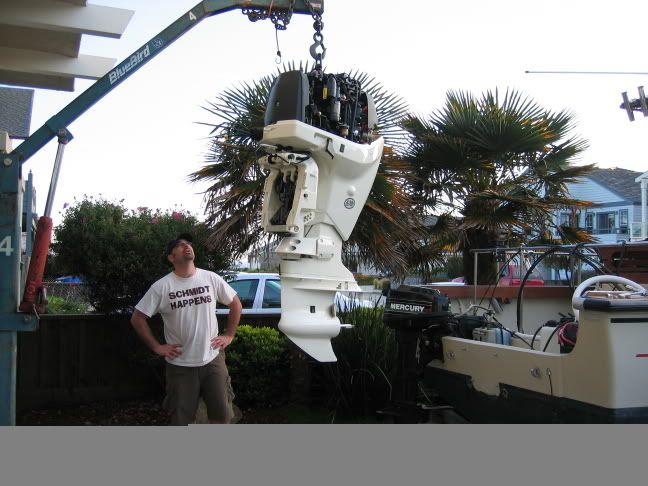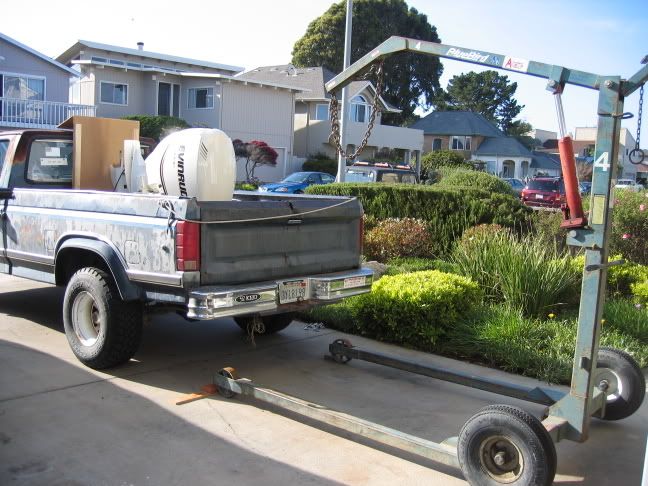Page 1 of 1
Repairing (Not Replacing) Drain Tubes
Posted: Fri Nov 11, 2016 3:54 pm
by Ducktown
My 1988 Montauk's two transom well drain tubes are corroded and surely are allowing water to enter the hull. I am unable to replace them because the boat has been fitted with a jack plate that partially covers the tube openings on the exterior of the transom. The only way to replace the tubes would be to pull the motor and jack plate off the boat, which I have no intention of doing.
What is the best way to seal and re-seal the tubes so they become watertight? A simple coat of 3M4200 or some other sealant? Some other option?
Re: Repairing (Not Replacing) Drain Tubes
Posted: Sat Nov 12, 2016 10:02 am
by Jefecinco
I don't believe the tubes can be repaired with an adhesive or sealant. When the tubes become unserviceable it's time to do the job properly.
It may be possible to do the job without removing the engine and jackplate by using Marelon fittings and a good caulk. I would not use 3M 5200 adhesive. It would be extremely difficult to remove in the future and would not promise a successful repair.
If you can remove the defective tubing from inside the cockpit you may be able to push replacement threaded Marelon pipe back through the transom from the cockpit. It would not require much space between the jackplate and transom to put the flanged Marelon nut on the threaded pipe. Generous application of caulk to the pipe and nut would be needed.
Marelon through hull fittings in the needed size should be available from several on-line sources.
Re: Repairing (Not Replacing) Drain Tubes
Posted: Sat Nov 12, 2016 1:39 pm
by Ducktown
Unless the Marelon tubes are flexible, there's just not enough clearance in the well to slide a rigid tube through from inside to outside.
Re: Repairing (Not Replacing) Drain Tubes
Posted: Sat Nov 12, 2016 1:47 pm
by Ducktown
Other than serving to drain the transom well (and run transducer cable through), how important are these drain tubes to the overall function of the boat? Hypothetically, if I were to remove the damaged tubes and solid fill the voids, what might the consequences be beyond needing to find another way to remove water from the well? Further, what is the real purpose of the well?
Re: Repairing (Not Replacing) Drain Tubes
Posted: Fri Nov 18, 2016 3:11 pm
by steelhead55
I have actually seen this done on a 1979 V-22 Revenge. You would have to talk to Garris about its effectiveness, but I believe it is not a bad idea. Water from the rear splash wells tends to just sit there, and could easily be removed by a smallish bilge pump.
I see no real negatives from doing this, and it may just help save your transom from wood rot.
Re: Repairing (Not Replacing) Drain Tubes
Posted: Fri Nov 18, 2016 4:36 pm
by Phil T
Not removing the motor and jack plate is like saying you want to change a car tire without taking the rim off the vehicle.
Removing the motor and jackplate is a straight forward DIY. You don't have to derig the engine. You just need a extra set of hands at one crucial step. We can help you step by step.
Re: Repairing (Not Replacing) Drain Tubes
Posted: Sat Nov 19, 2016 8:30 am
by jimh
Ducktown wrote:Other than serving to drain the transom well (and run transponder cable through), how important are these drain tubes to the overall function of the boat?
The transom splash well drains are not conduits for rigging. They are drains. Don't run electrical cables through them.
If the transom splash has no drain, water splashing into the splash well will collect in the splash well. The water will have to be removed from the splash well by some other method.
Permanently filling the transom splash well drains will be more work than replacing the drain tubes.
Re: Repairing (Not Replacing) Drain Tubes
Posted: Fri Nov 25, 2016 10:27 am
by Ducktown
A couple of follow-up questions:
Phil - I have a 90 hp E-Tec. (At the risk of showing my ignorance,) without a mechanical hoist of some kind, how is removing it a DIY job? I'd attempt it if it didn't involve busting a gut.
Jim - Is there some other safety or performance related concern with running a transducer (or other electrical) cable through a drain tube other than it restricting the flow of water somewhat?
Re: Repairing (Not Replacing) Drain Tubes
Posted: Sat Nov 26, 2016 11:21 am
by Jefecinco
A backyard tree with a stout limb will do for a lift. Attach a line to the engine, toss the line over the limb, tie off the line to the trunk. The engine should be prepositioned as close to a vertical line drop as possible. The drop line can be positioned over the limb while pushing the trailer under the limb to help with alignment. Remove the engine mounting bolts and rigging fasteners and swing the engine out of the way with another line which can be made fast to the tree trunk. Replace the drainwell tubes and reverse the process. Clean off the old engine mounting bolt caulk and use liberal amounts of new caulk when reinstalling the bolts. I like BoatLife caulk.
Re: Repairing (Not Replacing) Drain Tubes
Posted: Wed Jan 11, 2017 4:58 pm
by andygere
A very easy and safe way to lift the outboard is using an automotive engine hoist rented from your local rental yard. I removed a 200 hp Mercury and installed a new ETEC 200 in my driveway after work in a single evening. The hoist was the type that tilts down and is towed behind your truck with an ordinary hitch. For a 90 horse, you may be able to get away with a smaller hoist (cherry picker) but this one was super stable and easy to maneuver.


You'll need a lifting ring for the motor (an Evinrude dealer will sell you one, but you may be able to borrow or rent one) to lift if with the engine hoist. It's no big deal to unbolt the motor, lift it out of the way (with the rigging still connected) and replace the drain tube properly. The job can be easily done, soup to nuts, in a single day.
Re: Repairing (Not Replacing) Drain Tubes
Posted: Thu Jan 12, 2017 6:50 pm
by Ducktown
admirable! And great pics, too! I've gone from "no intention of pulling the motor" to possibly considering it.
Anyone have experience doing this with a jack plate setup? Is it possible to simply unbolt the jack plate, leaving the motor attached, or does the motor block access to the jack plate fasteners? Apologies for my laziness, but the boat is under wraps several miles away right now, so I can't peek at it.

